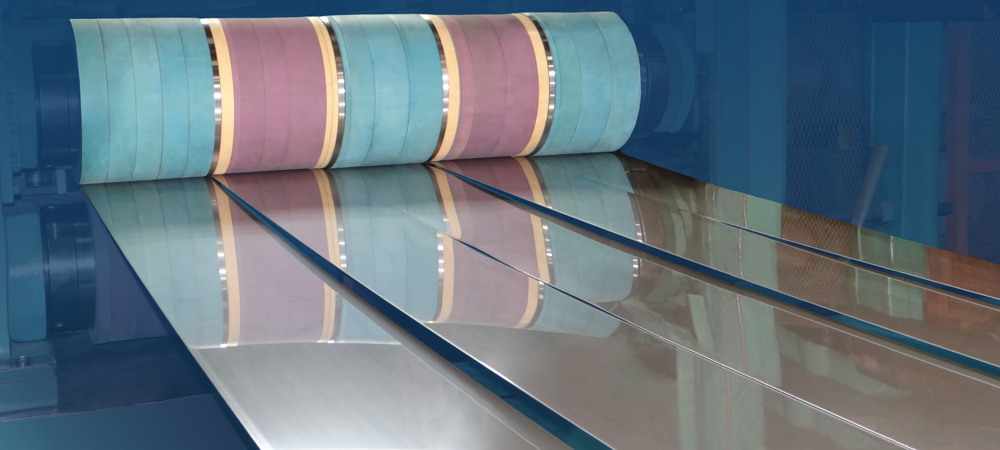Slitting and Edging (Edge Conditioning) Stainless Steel Strip
As industries advance, the demand for slit coil to meet strict and precise requirements also increases. Steel coils must improve efficiency and productivity while exceeding rigorous industry standards. One way to meet this demand is through slitting and edge conditioning.
Slitting and edge conditioning (also known as skiving) are essential parts of steel processing that increase the quality and safety of the final product. While some applications do not require extensive or precise slitting and edging, most industries profit from the practical benefits offered only by slit and conditioned metal.

How the Slitting and Edge Conditioning Process Works for Stainless Steel Slit Coil
Steel slitting is a process that cuts a wide master coil of metal into narrower strands that have more consistent measurements. Manufacturers simply feed the large stainless steel through a machine called a slitter, then recoil the resulting strands into a finished coil. However, the machine’s knives leave behind a burr on the slit edge.
A slitting burr can be a benefit when it comes to welding, but in many cases, sharp edges are more of a hindrance than a help. That’s where edge conditioning, also known as edging, comes in. Edging is the process that smooths or rounds the sharp edges of slit metal to remove the burr and make it safer to handle and use in exposed applications. Conditioned edges are available in several shapes: deburred, square, round, rolled, beveled, and even custom edges.
Types of Steel Used in Slitting and Edging
Any type of steel can undergo slitting and edging, but not every metal is compatible with every type of edging. You may be limited in your choice of edging by steel grade, size, and width tolerance.
For instance, some edges work better on harder grades of stainless steel, but the same edging could weaken or shred softer steel. In addition, certain edge shapes also have width and material thickness limitations. Even if your preferred edge isn’t suitable for your application, you don’t need to worry about quality. Any type of edging improves the quality of your strip and removes rough edges.
The cutting machine also makes a difference to the material that you use. Most cutting machines function similarly, but parameters like the cutting tool, the rake angle, and even how the metal is coiled can affect the finished product.
Precision re-roll mills and service centers like Ulbrich’s, with decades of slitting and edging expertise, can recommend the proper skived edge for your metal and application’s needs.

Benefits of Slitting and Edge Conditioning
Proper slitting and edge conditioning is important for three reasons: functionality, safety, and aesthetic.
Functionality
The functional benefits of a slit coil include the following:
- Improved efficiency: slit and edged metal is easier and faster to feed through machinery
- Coil customizability: slit coils are rerolled to your inner diameter and coil size specifications
- Higher-quality products: edging results in a more uniform metal
- Extended life expectancy: conditioning prevents edge cracking and increases formability
In addition, stainless steel objects like food trays or soup ladles simply wouldn’t be functional without proper edge conditioning. In other words, conditioning is much more than removing a slitting burr; it’s often a required processing step for product functionality.
Safety
Raw or rough metal edges are a serious safety hazard. A slitting burr can put both workers and consumers at risk of cuts and scrapes. However, an edge-conditioned metal is smooth on all sides, securing safer handling practices without hazardous burrs. It won’t snag on skin or clothing—which prevents injuries, reduces liability, and improves employee safety.
That said, we recommend that anyone handling slit coil should wear gloves and arm guards, no matter the condition of the edge,
Sharp edges on your strip coil can also cause damage to processing machines. They can even cut wires and other delicate objects they come into contact with during processing and assembly. The right edge conditioning can protect and extend the life of your machinery and tools.

Aesthetic
Finally, smooth edges are more aesthetically pleasing. Rough edges are unacceptable for consumer stainless steel products. Imagine a stainless steel refrigerator—without perfectly rounded edges, it will look cheap and unattractive.
Plus, slitting and edging can remove imperfections from the surface of the metal.
Practical Applications for Slitting and Edging Stainless Steel Strip
A slit coil has countless practical applications. First, slitting allows you to buy metal strip closer to the finished size of your product, which reduces waste and saves processing time. In addition, because slitting and edging produce more consistent and higher-quality metal products, you can use the conditioned steel in markets and applications that demand precision and tight tolerances, such as:

- Electronics
- Medical
- Food service
- Automotive
- Residential
- Telecommunications
- Aerospace
- Environmental
Some of the most common uses for conditioned stainless steel include surgical instruments, flexible metal hose, hypodermic needles, and superconductors. Rounded and polished coils can also serve decorative purposes, and they often feature as design elements in the automotive industries.
In short, stainless steel slit coil is attractive to many industries; it’s versatile, easy to sterilize, and not prone to corrosion or rusting. With the addition of processing like slitting and edging, it becomes an even more practical and efficient choice for many precision products. Precision cutting methods can create ideal characteristics for many critical applications.
Learn More about Slitting and Edging
For the safest and most efficient processing, your slit coil must be cut above the rest. Properly slitting and edging your stainless steel strip ensures the best-quality final product and an improved handling experience. Slitting and edging are crucial for clean and safe metal edges in all industries and applications.
For more information about the slitting and edge conditioning services available at Ulbrich, contact us today. A specialist can answer questions about your specific needs, or you can request a quote right away.


